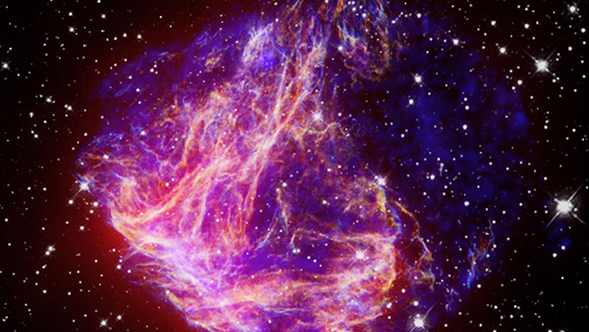
News Release • November 29th, 2006 • feature06-35 •
Written by Jim Keller
Spitzer Science Center
NASA's Great Observatories -- Spitzer, Hubble, and Chandra -- are working together to unlock the mysterious structure of a supernova remnant in a nearby galaxy.
Supernova Remnant N49 is, in optical light, the brightest supernova remnant in the Large Magellanic Cloud, a nearby satellite galaxy of our own Milky Way Galaxy. To visible-light observatories, N49 appears to have a unique, lopsided filamentary structure which has long puzzled scientists because most supernova remnants appear spherical in shape.
By using Spitzer and Chandra to map gas and dust in the area, astronomers have determined that the funny shape of N49 is being caused by the supernova remnant expanding into a region of denser gas on one side.
Infrared emission (red in the image) comes mostly from gas being heated up by the supernova remnant's expanding shell. Surprisingly, not as much of the infrared light is due to dust particles, as is seen in other supernova remnants. Hubble mapped the visible-light structure, which can be seen as yellow and white in the image, and Chandra mapped the location of hot gas, which can be seen as blue in the image.
NASA's Great Observatories Program is a family of four orbiting observatories, each observing the Universe in a different kind of light (visible, gamma rays, X-rays, and infrared). The Spitzer Space Telescope is the infrared Great Observatory. Other missions in this program include the Hubble Space Telescope, the Chandra X-Ray Observatory, and the now-defunct Compton Gamma-Ray Observatory.





